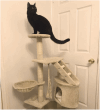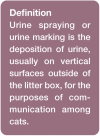Common feline problem behaviors: Urine spraying
- PMID: 30810092
- PMCID: PMC11373755
- DOI: 10.1177/1098612X19831203
Common feline problem behaviors: Urine spraying
Erratum in
-
Common feline problem behaviors: urine spraying.J Feline Med Surg. 2019 Oct;21(10):NP5. doi: 10.1177/1098612X19873776. J Feline Med Surg. 2019. PMID: 31551017 Free PMC article. No abstract available.
Abstract
Practical relevance: Urine spraying (synonymous terms include urine marking or scent marking) is commonly described as urine deposited on vertical surfaces while the cat is in a standing position. With the increasing trend of keeping cats indoors in some countries and the potential resultant increase in frustration-related behaviors, urine spraying may occur in the home. Although also a normal feline behavior, it is usually not deemed acceptable when the cat targets household possessions. Urine spraying is a common behavioral complaint that practitioners receive from cat owners and has the potential to disrupt the human-cat bond. In fact, feline elimination issues are a frequent reason cited by owners when they relinquish their cats to shelters and rescue organizations.
Clinical challenges: While the location of the deposited urine should be diagnostic, this is not always the case. Urine marking can occur on horizontal surfaces, thus complicating the diagnosis. Urine spraying by intact males and females is used to signal availability for mating but the behaviour can also be exhibited by neutered animals. Multiple factors including medical problems can trigger the onset and maintenance of urine spraying, and correct identification of these is necessary for treatment to be most successful.
Evidence base: This review draws on information from multiple studies that have been published on the normal aspects of urine spraying in cats, the frequency as reported by owners, the relationship of urine spraying to intercat aggression and various treatment options including behavior modification, pheromone therapy and use of psychoactive medication.
Keywords: Urine spraying; intercat aggression; normal behavior; vertical deposition.
Conflict of interest statement
The author declared no potential conflicts of interest with respect to the research, authorship, and/or publication of this article.
Figures

















References
-
- Natoli E. Behavioural responses of urban feral cats to different types of urine marks. Behaviour 1985; 94: 234-243.
-
- Pryor PA, Hart BL, Bain MJ, et al.. Causes of urine marking in cats and effects of environmental management on frequency of marking. J Am Vet Med Assoc 2001; 219: 1709-1713. - PubMed
-
- Hart BL, Cooper L. Factors relating to urine spraying and fighting in prepubertally gonadectomized cats. J Am Vet Med Assoc 1984; 184: 1255-1258. - PubMed
-
- Howe LM, Slater MR, Boothe HW, et al.. Long-term outcome of gonadectomy performed at an early age or traditional age in cats. J Am Vet Med Assoc 2000; 217: 1661-1665. - PubMed
-
- Porters N, de Rooster H, Verschueren K, et al.. Development of behavior in adopted shelter kittens after gonadectomy performed at an early age or at a traditional age. J Vet Behav 2014; 9: 196-206.
Publication types
MeSH terms
Substances
LinkOut - more resources
Full Text Sources
Miscellaneous

